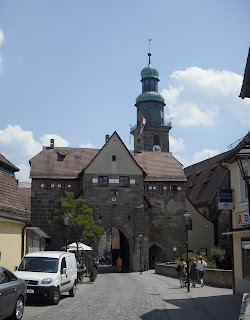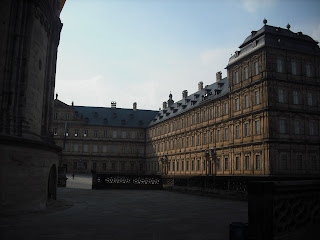
Here is a monument that truly deserves its title, a beautiful fountain. It's in the northwest corner of the Hauptmarkt.
I indulged in a bit of nostalgia this afternoon. Well, more curiosity than anything else. I wanted to visit the neighborhoods I lived in forty years ago to see what they were like. First I walked out to Rennweg, in a nice residential area north of the Altstadt. I found the house I lived in during my second and third years here. It looked much the same, even had the same door. Isn't it interesting how one forgotten object can evoke so many memories of the past? A few blocks away is the Stadtpark, in its day one of the nicest parks anywhere. The lovely restaurant/café I remembered, situated on a pond, has closed down and is now overgrown with weeds. The formal gardens, once meticulously kept up, are now pretty shabby. The lawns need a good mowing. It is a bit sad to see the park go downhill.
Not a lot has changed in Nürnberg. The biggest thing is the subway that was built about twenty years ago. The city already had an extensive tram/bus network but it built a subway system as well. And not just a few stops -- it goes everywhere. I can't help thinking of Kansas City, a much bigger city, which has a laughable public transit system and has been dithering for the past twenty years about building a modest tram line.
I took the subway (Untergrundbahn) out to the south part of the city to visit the street I lived in during my first year in Nürnberg. I haven't walked down that street in forty-two years. It was much the same. I opted to walk back to town. Many people were out and about on the warm summer afternoon, chatting on cell phones, walking with friends and family. I hardly heard a word of German spoken the whole time. I heard Russian, Turkish and dog knows what else. Like most countries in Europe, Germany has been overrun by other nationalities. I walked out to a vegetarian restaurant I had located on the internet. It was a bit of a schlepp, but well worth it. Vegetarian cuisine in Germany (when you could find it) used to be a little weird. This was faaaabulous. I had the Aryuvedische Teller which was basically an Indian dinner. Fragrant rice with veggies in a mild curry sauce, some yellow dahl sambhar for protein, cucumber raita and two chutneys, one of walnut/apple (I think it was just these two items mixed in a blender) and apricot. Delizioso!












































